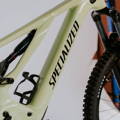Between $2,500 and $3,000 hits the sweet spot for entry- to mid-tier electric mountain bikes. That price range opens up the range of e-MTBs from top brands like Trek, Giant, Specialized, and others with innovative designs and quality parts. Models that fall into that price range are typically hardtail mountain e-bikes or pre-owned full-suspension models.
Spending less than $2,000 means the e-bike will likely come with a rear hub motor, less premium mid-drive unit, or an external battery. Riders can browse the best mountain bikes for under $2,000 designed for recreational riding and lighter mountain biking.
Mid-Drive Motors Are Better for E-MTBs: Here's Why
Written by: Rémy Rossi | July 20, 2025 | Time to read 4 min
Everyone says mid-drive motors are better for electric mountain bikes— here’s what makes them worth it on rugged trails and steep climbs.

More about the Author: Remy Rossi
Rémy Rossi is a bike writer, mechanic, and educator who got his start in community-based bike shops and co-ops. With a decade in the industry, he still wrenches on bikes when he can and plays bike polo on a fixie.

There are big benefits to handling, hill climbing, ride feel, and efficiency when you opt for a mid-drive motor, though riders on calmer, paved terrain can run hub motors without feeling like they’re missing out. For steep hills and trail riding, however, mid-drive motors are the right choice for electric mountain bikes.
Table of Contents
Hub motors vs. mid-drive motors: What’s really the difference?

Mid-drive units are head and shoulders above their hub-drive counterparts when it comes to steep, technical riding, but I’m not here to throw shade on hub motors either. Bike nerds love to split hairs and say motor types are wildly different in feel, but on calm terrain, the difference in feel and performance for recreational riders is not so big. But I’m feeling like giving a haircut, so let's slice through the advantages of mid-drive motors on e-MTBs!
Benefits of mid-drive motors on electric mountain bikes
Better weight distribution and handling

A mid-drive motor also reduces the amount of unsprung mass on full-suspension electric mountain bikes. Unsprung mass is the weight of bike parts directly connected to the wheels— rather than the frame and rear shock itself— that moves when going over bumps and uneven terrain. Extra mass on the rear wheel— such as a hub motor— reduces the suspension’s performance and can decrease traction. A mid-drive motor avoids this problem altogether.
🤝 Get an even better discount when you trade in your electric bike now!
Click here for a price estimation
Superior torque and climbing hills

Mountain biking, unlike other types of riding, often involves some pretty crazy climbs, ones that are much steeper than typical hills that city e-Bikes or hub-drive electric bikes are designed for. The torque levels and connection to the bike’s drivetrain allow mid-drive motors to excel on the toughest slopes without straining.
More natural pedaling feel

Mid-drive motors deliver power directly to the electric mountain bike’s drivetrain, which is the same spot you put the power down when pedaling. The result is a more natural boost that feels more like an amplification of your own pedal power rather than an external push. Rear hub motors can seem like a push from behind, whereas front hub motors can give the impression of being pulled along— both fun sensations, but perhaps not what you’re looking for out on the trail.
🤝 Why you can trust us for buying an e-Bike?
- Great prices: Get your next e-Bike for up to 60% off retail prices, in new or like-new conditions.
- Quality Guaranteed: Every e-Bike is rigorously certified by a team of professional mechanics, and comes with a 1-year warranty.
- Delivered to Your Door: Delivered to your home within a week. Change your mind? Return it thanks to our 14-day return policy.
Higher efficiency
Mid-drive motors are much better at staying within their optimal rpm range thanks to the bike’s gearing. This limits motor strain and overheating. Mid-drive units are also typically better at cooling, while hub motors have little opportunity or heat sink spots to dissipate heat. Hub-drive motors, on the other hand, have one “sweet spot” when it comes to rpm.
Frequently Asked Questions
How much should you spend on an electric mountain bike?
How much should you spend on an electric mountain bike?
Between $2,500 and $3,000 hits the sweet spot for entry- to mid-tier electric mountain bikes. That price range opens up the range of e-MTBs from top brands like Trek, Giant, Specialized, and others with innovative designs and quality parts. Models that fall into that price range are typically hardtail mountain e-bikes or pre-owned full-suspension models.
Spending less than $2,000 means the e-bike will likely come with a rear hub motor, less premium mid-drive unit, or an external battery. Riders can browse the best mountain bikes for under $2,000 designed for recreational riding and lighter mountain biking.
Where can I find trails that allow electric mountain bikes?
Apps such as Trailforks have an e-MTB filter to find routes that allow electric mountain bikes. E-Bike owners can filter the Trailforks map on the website or app to show trails where e-MTBs are permitted.
Key Takeaways
- Better handling: Mid-drive motors offer balanced weight distribution and improved suspension performance for technical terrain.
- Climbing power: They deliver more usable torque by working with your bike’s gears, perfect for steep and challenging trails.
- Natural feel & efficiency: Torque-based assistance and drivetrain integration make pedaling feel intuitive and extend your ride range.


